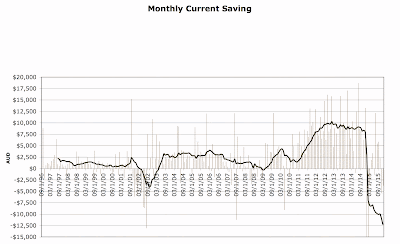Another month flies by. Financial markets were mixed, falling in Australia and rising globally. We earned a lot of extra income this month. Here are our monthly accounts (in AUD):
"Current Other income", which is mainly salaries was very high at $29k. The main reason is that I finally got paid some back pay for the additional duties I have taken on. From now on my usual salary will be a little higher, though I really hope to get out of these duties by the end of the year as with the baby and these it is hard to get my core job functions done. We also got the first childcare subsidy payment of $1.3k which covers the months of February and March. We will get this payment quarterly. On top of that this was a three paycheck month - we are paid every two weeks here in Australia.
Spending (not counting mortgage) was moderate at $6.0k. After taking into account the mortgage payment of $3.8k (which includes implicit interest saving due to our offset account - the actual mortgage payment was about $641 less than this) - which shows up as a transfer to the housing account, we saved $19k on the current account. We made $6.9k of retirement contributions, which is very high due to the extra pay, and saved a net $1.9k in added housing equity. Net saving was, therefore, $28k across the board. I increased the carrying value of our house by $2k, following the local auction.
The Australian Dollar fell slightly from USD 0.7475 to USD 0.7437. The ASX 200 fell by 2.75%, the MSCI World Index gained 2.3%, and the S&P 500 1.41%. We gained 0.06% in Australian Dollar terms and lost 0.45% in US Dollar terms. So, we outperformed the Australian market and underperformed the international markets. The best performer in dollar terms was Oceania Capital Partners up $4.4k - this is a thinly traded and volatile stock. Next best was Platinum Capital, gaining $3.4k across our various different holdings. The worst performer was the CFS Geared Share Fund, losing $16k. Private equity was the best performing asset class, followed by hedge funds. All other asset classes gained apart from Australian shares, with large cap Australian shares the worst performer.
As a result of all this, net worth rose AUD 32k to $1.832 million (new high) or rose USD 17k to $US 1.362 million (also a new high).
"Current Other income", which is mainly salaries was very high at $29k. The main reason is that I finally got paid some back pay for the additional duties I have taken on. From now on my usual salary will be a little higher, though I really hope to get out of these duties by the end of the year as with the baby and these it is hard to get my core job functions done. We also got the first childcare subsidy payment of $1.3k which covers the months of February and March. We will get this payment quarterly. On top of that this was a three paycheck month - we are paid every two weeks here in Australia.
Spending (not counting mortgage) was moderate at $6.0k. After taking into account the mortgage payment of $3.8k (which includes implicit interest saving due to our offset account - the actual mortgage payment was about $641 less than this) - which shows up as a transfer to the housing account, we saved $19k on the current account. We made $6.9k of retirement contributions, which is very high due to the extra pay, and saved a net $1.9k in added housing equity. Net saving was, therefore, $28k across the board. I increased the carrying value of our house by $2k, following the local auction.
The Australian Dollar fell slightly from USD 0.7475 to USD 0.7437. The ASX 200 fell by 2.75%, the MSCI World Index gained 2.3%, and the S&P 500 1.41%. We gained 0.06% in Australian Dollar terms and lost 0.45% in US Dollar terms. So, we outperformed the Australian market and underperformed the international markets. The best performer in dollar terms was Oceania Capital Partners up $4.4k - this is a thinly traded and volatile stock. Next best was Platinum Capital, gaining $3.4k across our various different holdings. The worst performer was the CFS Geared Share Fund, losing $16k. Private equity was the best performing asset class, followed by hedge funds. All other asset classes gained apart from Australian shares, with large cap Australian shares the worst performer.
As a result of all this, net worth rose AUD 32k to $1.832 million (new high) or rose USD 17k to $US 1.362 million (also a new high).



































